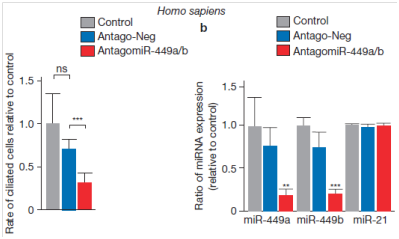miRNA as new targets for the treatment of respiratory diseases
Référence
02884-01
Mots-clés
Statut des brevets
French patent application FR0903723 filed on July 29th, 2009 entitled « Utilisation de microARN pour le traitement de pathologies respiratoires chroniques »





Inventeurs
Brice MARCET
Pascal BARBRY
Rainer WALDMANN
Bernard MARI
Christelle CORAUX
Statut commercial
Exclusive or non-exclusive licenses, Collaborative agreement
Laboratoire
Institut de Pharmacologie Moléculaire et Cellulaire, a CNRS-Université de Nice laboratory (UMR 6097) in Nice, France.
Description
CONTEXT
Multiciliated cells lining the surface of some vertebrate epithelia are essential for various physiological processes, such as airway cleansing. In many respiratory diseases, among which asthma cystic fibrosis and chronic obstructive pulmonary disease, these cells lose their cilia and cannot evacuate mucus and noxious particles anymore. It is thought that restoring this physiological feature may be of great help in the treatment of respiratory diseases, but until recently, little was known on the molecular pathway of multicilogenesis.
TECHNICAL DESCRIPTION
Dr Marcet’s team has described new microRNAs specifically expressed in multiciliated cells and implicated in the biosynthesis of these particular structures. When administered to cultured cells, the miR, or their antago-miR, modulate the expression of a panel of genes and are able to induce or block the formation of motile cilia.
In particular, miR449 has been shown to be strongly accumulated in human airway epithelium and Xenopus laevis embryonic epidermis, where it promotes multiciliogenesis and centriole multiplication by directly repressing the Delta/Notch pathway.

HAECs (n=6 donors) were chronically treated with anti-miR-449a/b or control antagomiR (20 nM) during the time of differentiation, typically for 21 days at an air_liquid interface. (a) The relative rate of multiciliated cells was defined as the ratio of the number of β4-tubulin-positive cells to the number of nuclei (20 fields per filter, and 3 inserts per donor, n=6 donors). The histogram indicates the relative rate of multiciliated cells per field in each experimental condition, with the control set to 1. Data are means ± s.d. from six donors (***, P <0:001, Student’s t -test). (b) Real-time RT-PCR experiments indicate that antagomiR-449a/b inhibits miR-449a and miR-449b expression and has no effect on the unrelated microRNA miR-21.
Data are means± s.d. from six donors (ns, not significant, **, P <0:01, ***, P <0:001, Student’s t -test).
One aspect of the invention consists in the use of these miRNA for the treatment of multiciliated cells disorders. The second aspect of this invention consists in the detection of the level of these miRNA in respiratory epithelia to determine their level of distress.
INDUSTRIAL APPLICATIONS
- Pharmaceutical compositions for the treatment of respiratory diseases: asthma, COPD, cystic fibrosis, flu, etc…
- Diagnostic of multiciliated cells distress in respiratory diseases, follow-up of treatment.
BENEFITS
This invention consists in new targets for the treatment of respiratory diseases which enable restoration of a functional respiratory epithelium, and provide means to monitor the state of health of multiciliated epithelia. MicroRNA and their antago-miR are short ribonuceic acid molecules which have proven to be more stable and less fragile than longer RNA or DNA molecules used in genetic therapy. The feasability of their administration by inhalation is very likely.
DEVELOPMENT STAGE
The in vitro proof-of concept has been obtained on cell lines and nasal mucous tissue for several miRNA. Validation is ongoing on mouse models of asthma.
PUBLICATIONS
MicroRNA-based silencing of Delta/Notch signaling promotes multiple cilia formation. Marcet B, Chevalier B, Coraux C, Kodjabachian L, Barbry P. Cell Cycle. 2011 Sep 1;10(17):2858-64. Epub 2011 Sep 1. Review.
Control of vertebrate multiciliogenesis by miR-449 through direct repression of the Delta/Notch pathway. Marcet B, Chevalier B, Luxardi G, Coraux C, Zaragosi LE, Cibois M, Robbe-Sermesant K, Jolly T, Cardinaud B, Moreilhon C, Giovannini-Chami L, Nawrocki-Raby B, Birembaut P, Waldmann R, Kodjabachian L, Barbry P. Nat Cell Biol. 2011 Jun;13(6):693-9. Epub 2011 May 22. Erratum in: Nat Cell Biol. 2011 Oct;13(10):1280.
For further information, please contact us (Ref 02884-01)
Besoin de plus d'informations ?
Nous contacterTechnologies Liées
-
31.03.2015
Protein involved in DNA replication, and modulation of its activity
Santé / Thérapeutique, Diagnostic médical 06081-01
-
10.03.2014
Protein complex mcm8/mcm9, inhibitors thereof, and their use for enhancing or reducing animal fertility
Santé / Thérapeutique, Autres technologies 00017-04
-
03.03.2014
Chimeric molecule involving oligomerized FasL extracellular domain
Santé / Thérapeutique 03946-01